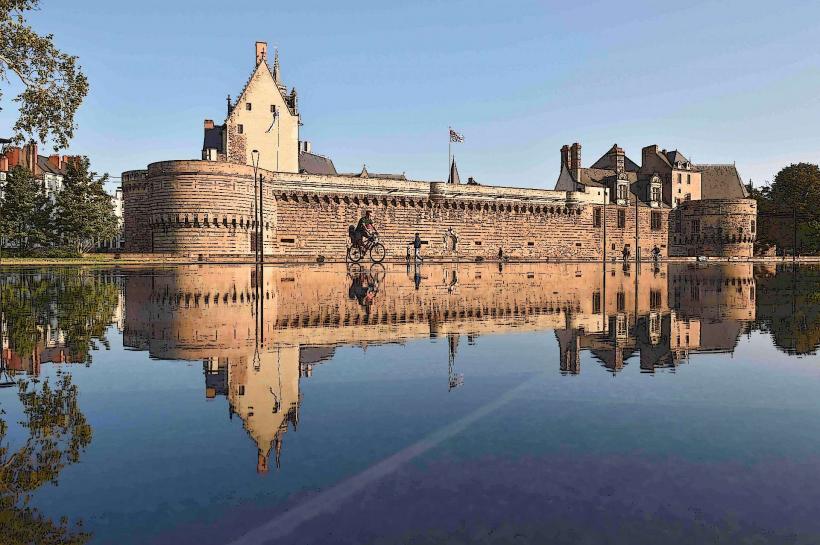Information
Landmark: Nantes CathedralCity: Nantes
Country: France
Continent: Europe
Nantes Cathedral (officially Cathédrale Saint-Pierre et Saint-Paul de Nantes) is a significant Gothic cathedral located in the city of Nantes, in the western part of France. This cathedral is one of the most important religious and historical landmarks in the city, showcasing a combination of architectural styles, historical events, and cultural importance.
History and Significance
Foundation and Construction: The construction of Nantes Cathedral began in 1434 and continued for several centuries, with significant periods of work extending into the 19th century. The cathedral is dedicated to Saint Peter and Saint Paul, reflecting the importance of these two apostles in the Christian tradition.
Gothic Architecture: The cathedral is primarily built in the Gothic style, with elements of Flamboyant Gothic seen in its intricate details. Over time, the cathedral also incorporated some Renaissance and Classical features due to the prolonged construction period, making it an interesting example of evolving architectural styles.
Role in Nantes' History: The cathedral served as the seat of the Archdiocese of Nantes. It has witnessed numerous significant events in the history of the city, including royal ceremonies, religious processions, and periods of political turmoil. For example, during the French Revolution, it was used for various purposes, including as a place of worship and as a symbol of the resilience of the Catholic Church in France.
Architectural Highlights
Facade: The cathedral’s facade is a striking feature, combining elements of Flamboyant Gothic and Renaissance styles. It features two tall towers with ornate windows and doorways, which were completed in the 16th century, offering a grand entrance into the cathedral.
Interior: Inside, the cathedral is vast and impressive, with high vaulted ceilings, soaring columns, and intricate stained-glass windows. The nave is particularly notable for its elegant proportions and stunning stained-glass panels, many of which date back to the 15th and 16th centuries.
Tombs of the Dukes of Brittany: One of the most significant historical features inside the cathedral is the tomb of François II, the last Duke of Brittany, and his daughter, Anne of Brittany. Their tombs are located in the choir of the cathedral and are decorated with intricate sculptures that reflect the wealth and power of the ducal family during their reign.
Organ: The cathedral is also famous for its grand organs, particularly the Cavaillé-Coll organ, one of the most important organs in France. It is used for both regular worship services and concert performances, and it adds to the rich acoustics of the cathedral.
Modern-Day Significance
Cultural Importance: Today, Nantes Cathedral remains a central landmark in the city and a key part of Nantes' cultural heritage. It attracts visitors not only for its religious significance but also for its architectural beauty and connection to the city’s historical identity.
Restoration: Over the years, the cathedral has undergone various restoration projects to maintain its structural integrity. It was heavily damaged in a fire in 2020, which destroyed the organ and damaged parts of the building. However, restoration efforts have been ongoing, and the cathedral remains an active place of worship, along with being a major tourist attraction.
Location and Accessibility
Nantes Cathedral is located in the city center of Nantes, on the banks of the Loire River, and is easily accessible to both locals and tourists. It stands near the Place Saint-Pierre, a central square that is part of the city’s historic district. Visitors can explore the cathedral, enjoy its quiet and peaceful interior, and also take in the surrounding historic architecture of Nantes.
Key Features and Attractions
- Massive Gothic Architecture: The cathedral’s high ceilings, intricate stone carvings, and detailed stained-glass windows make it a must-see for those interested in medieval and gothic architecture.
- The Tombs of the Dukes of Brittany: As the final resting place of some of the region's most influential figures, these tombs hold great historical and artistic significance.
- The Organ: A piece of musical heritage, the cathedral's organ is famous for its sound and used regularly in concerts and services.
Conclusion
Nantes Cathedral stands as an enduring symbol of religious and architectural history in the city. Its combination of Gothic splendor, historical significance, and artistic features makes it a landmark that draws visitors from all over the world. Whether you are an architecture enthusiast, a history lover, or someone interested in the cultural heritage of Nantes, this cathedral is a must-see destination.








